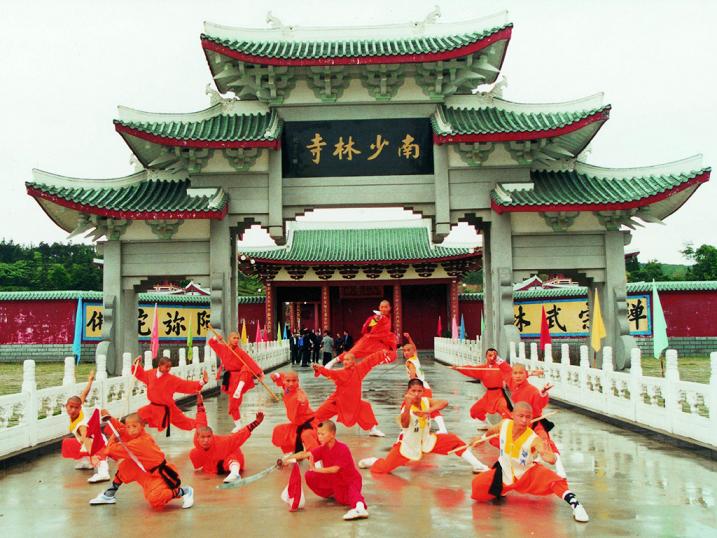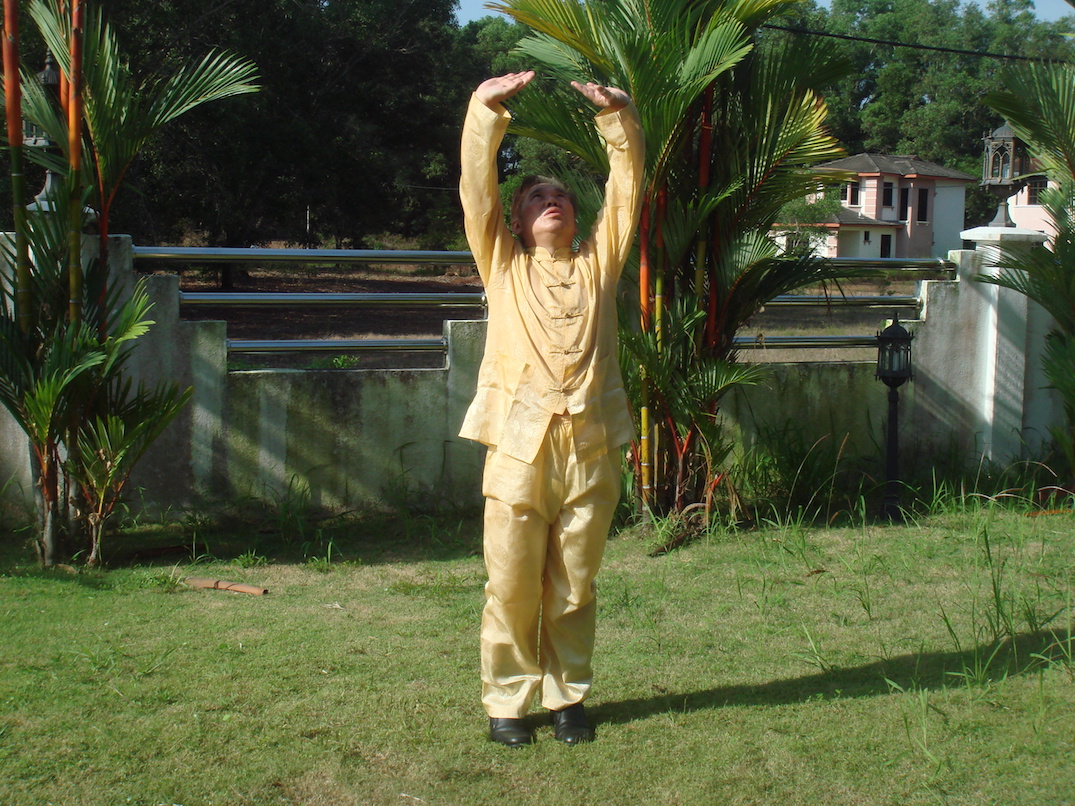SELECTION OF QUESTIONS AND ANSWERS
MAY 2015 PART 2

The northern Shaolin Temple. Picture taken from http://english.eastday.com/e/voy1/u1a4043498.html
Question 1
I have read your book, "The Art of Shaolin Kung Fu", numerous times, reading parts of it before attending a Shaolin wushu academy in China and rereading the whole book numerous times while I stayed there.
— Namir, USA
Answer
Many people have kindly commented that my book, "The Art of Shaolin Kung Ku", greatly inspired them in their practice. The book will show you, amongst other benefits, the philosophy and purpose of practicing Shaolin Kungfu, but you need to learn from competent teachers the skills of applying the techniques mentioned in the book to get desirable results.
Question 2
I should have heeded your warning with more tenacity, that if a Shaolin master gets angry easily, he is not a true Shaolin master; and that if a Shaolin master is reluctant to teach genuine kung fu sparring and instructs to use gloves during sparring (we only sparred during Sanda class), and if he focuses only on performing forms instead of applying them, then he is not a true and genuine master.
Answer
Your observation is exact. The three suggestions I gave -- namely, not getting angry easily, using kungfu techniques in sparring, applying forms and not just performing them -- provide an excellent way to tell whether an instructor is teaching genuine Shaolin Kungfu.

The southern Shaolin Temple. Picture taken from http://www.chinauniquetour.com/arts.asp?id=1343
Question 3
My first thoughts were whether they were really Shaolin monks?
Answer
Honestly, I don't like to state it publicly, but despite my dislike, when faced with a sincere seeker asking me for an answer, I choose to tell the truth. Many of the so-called Shaolin "monks" were accomplished wushu practitioners recruited by a clever German entrepreneur to act as Shaolin monks by shaving their hair and putting on a monk's robe to tour the West to demonstrate wushu as Shaolin Kungfu. Many of these "monks" remained in the West to teach wushu as Shaolin Kungfu.
We must be fair to these "monks". They never claimed to teach traditional Shaolin Kungfu, though some of them claimed to be successors to the Shaolin Temple, which I find misleading. They may, or may not, have learnt Zen or other Buddhist teachings from a genuine Shaolin monk (who probably did not practice traditional Shaolin Kungfu), but to imply that the wushu they teach is a succession of traditional Shaolin Kungfu in the past is grossly misleading.
Some Shaolin "monks" may not know the following historical facts. The Shaolin Temple in Henan, which these "monks" claimed lineage from, was not burnt by the Qing army. This northern Shaolin Temple remained throughout the Qing Dynasty, and was burnt only in 1928, i.e. 17 years after the Chinese Republic had overthrown the Qing Dynasty, by rival warlords using guns and cannons, with nothing to do with kungfu fighting. Before this burning, including during the later part of the Qing Dynasty for about a hundred years, the northern Shaolin Temple in Henan was deserted, with no kungfu or chi kung practiced there.
The burning of the Shaolin Temple, which is well known in kungfu circles, occurred in the southern Shaolin Temple. Not many people know that there were two southern Shaolin Temples, and both were burnt to the ground by the Qing army in the 1850s.
During the Ming Dynasty, which existed before the Qing Dynasty, an emperor built another Shaolin Temple in the south in the city of Quanzhou in Fujian Province, and moved the status of imperial temple from the northern to the southern Temple. When the Qing Dynasty replaced the Mong Dynasty, some Ming generals retreated to the southern Shaolin Temple at Quanzhou and plotted to overthrow the Qing.
The Qing emperor, Yong Cheng, who infiltrated into the Temple as a monk, ordered the burning of the Shaolin Temple at Quanzhou with the help of Lama experts from Tibet with their infamous flying guillotines.
The Venerable Chee Seen escaped to the Nine-Lotus Mountain, also in Fujian Province, and built a second southern Shaolin Temple. Unlike in the earlier Shaolin Temples, most of Chee Seen's disciples were laypersons, like Hoong Hei Koon, Lok Ah Choy and Fong Sai Yoke. This southern Shaolin Temple on Nine-Lotus Mountain was also burnt to the ground by the Qing army, led by Pak Mei.
Question 4
Then I proceeded to learn fitness exercises and always asked when were we going to learn to use the moves we learned in forms?
Answer
Wushu practitioners pay much attention to fitness exercises similar to Western gymnastic exercises. This is quite different from traditional Shaolin training which pay attention to energy exercises based on chi or energy flow.
Unfortunately, these fitness exercises make practitioners fit, but may not be healthy. There is a saying amongst wushu practitioners that they have to win trophies before 20. After 20 they have endured so much injury that they have to become coaches.

A wushu demonstration taken from http://wushuadventures.com/want-to-train-wushu-in-hong-kong/
Question 5
Communication with my teacher there was next to impossible. With or without a translator, I could not discuss my training with him.
To tell you the truth, I feel very wronged that I spent a year in China and my teacher has probably never been taught how to kung fu spar himself, and therefore he could not teach me. I was naive and thought that if they are from the Shaolin Temple then they know Kung Fu comprehensively.
Answer
Lack of communication is actually a norm, even with genuine masters. Not only there is a language problem, they also believe in a doctrine of no questions. Students only practice what they are told to. We in Shaolin Wahnam is a rare exception.
Your time in China is not wasted. You have learnt genuine Shaolin forms, but as wushu and not as traditional Shaolin Kungfu. The forms are similar. When you learn internal force and combat application from us in Shaolin Wahnam, you will be able to convert your wushu to traditional Shaolin Kungfu.
Question 6
While I was there, I made the most of it. Your book inspired me to train Ma Bu. When I arrived the students did three minutes of Ma Bu twice per week. I thought that was a joke. And you say in your book five minutes is the minimum. So drawing inspiration from your book when I did not get any from the teacher, I trained Ma Bu all year, and could hold it for 80 minutes at the end. I still train it
Answer
Mabu, or stance training, is the foundation of kungfu, expecially building internal force.
But it is not easy to practice stance training correctly. Many people practice it as an endurance exercise, which is a big mistake. Its secret, which I discovered after more than 30 years, is relaxation.
Remaining at a stance for 80 minutes, regardless of whether you have practiced it correctly or wrongly, is a remarkable achievement. Even if you had practiced wrongly, it is a testimony to your diligence and endurance. If you have practiced correctly, though not necessarily perfectly, you would have developed tremendous internal force.

Lifting the Sky
Question 7
You book discussed the spiritual aspects of Shaolin Kung Fu. I was very attracted to that, but after spending time amongst these supposedly temple-trained monks, I got less spiritual. I felt more dull training with gloves. The students at the school grow more and more troublesome, angry, and stupid instead of less as your book suggested proper training should do.
Answer
It is worthwhile to note that "spiritual" is not the same as "religious". Shaolin Kungfu and any kungfu are spiritual, but not religious. Practitioners develop their spirit besides their physical body, i.e. they become peaceful, happy and mentally fresh besides being healthy and full of vitality. You are right: becoming troublesome, angry and dull are certainly becoming less spiritual.
Editorial Note: Namir's other questions will be continued at May 2015 Part 3 issue of the Question-Answer Series.
Question 8
Recently I started practicing the pushing sky qigong exercise from your book and have gotten good results. Thank you very much for sharing these wonderful arts.
Although I practiced qigong for several years, the chi sensations were more localized in certain parts of my body. The pushing sky exercise produces soothing chi sensations that lasts throughout the day and is more spread out on the entire body.
I have applied for and will be attending your Intensive Chi Kung exercise in December to properly learn the skills.
Meanwhile, I do have a question and seek you advice:
Currently I am training for a fitness test, one of which requires me to run 2.4 km in a certain amount of time (13 minutes is the passing mark for my age group)
Although I had been able to pass the running test in past years, it had always been very straining. As I get older, it has become harder and always at the risk of injuries or becoming sick due to over-training.
I realize that this is not the way to train long-term, but am at a loss on how to approach it. When I try to run within comfortable limits, the timing is often not fast enough to pass the test. I wonder if you could advise on how to systematically train to run faster with endurance, without over-exerting myself?
— Gabriel, Singapore
Answer
Congratulations for having good results with "Lifting the Sky". I am glad you will attend the Intensive Chi Kung Course in December. Many people are amazed at the wonderful results of the course though it is only for a few days.
Applying chi kung for running or any activity without panting for breath and without feeling tired will be one of these benefits. But meanwhile you can try the following exercise.
Performing "Lifting the Sky" about 20 to 30 times. Then stand upright and be relaxed. If the chi starts to flow, relax and enjoy the flow. If there is no chi flow, it does not matter.
After a short period (about 3 to 5 minutes) of enjoying your chi flow or standing still, start running, first slowly then quite fast. Do not tense your muscles in you running, but let your chi flow, which may or may not manifested outwardly, do the running for you. You don't have to know how your chi flow do the running, but just have a gentle thought that it does the running for you.
Do not worry about your breathing, just breathe normally. In case your breathing starts to become fast, breathe out gently and keep your breathing slow. In this way you will find that you can complete your fitness test quick easily.
LINKS
Selected Reading
- Various Styles of Kungfu
- My Direct Experience of Dim Mak
- Chi Kung: the Art of Dveloping Energy
- Learning the Five-Flower-Cannon Sparring Set
- Combat Application of Eighteen-Lohan Fist
